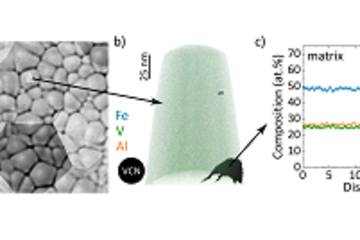All genres
41.
Proceedings
Microstructure And Mechanical Properties Of Additively Manufactured Pearl® Micro AD730®. World PM 2022 Congress and Exhibition, Code 188680, Lyon, France, October 09, 2022 - October 13, 2022. (2022)
42.
Conference Paper
Segregation of Solutes at Dislocations: A New Alloy Design Parameter for Advanced Superalloys. In: The Minerals, Metals & Materials Series, pp. 41 - 51. The 14th International Symposium on Superalloys
, Seven Springs , PA, USA, September 12, 2021 - September 16, 2021. (2020)
43.
Conference Paper
Deformation of Borides in Nickel-based Superalloys: a Study of Segregation at Dislocations. M & M 2019 - Microscopy & Microanalysis, Portland, OR, USA, August 04, 2019 - August 08, 2019. Microscopy and Microanalysis 25, S2 Ed., pp. 2538 - 2539 (2019)
44.
Talk
Understanding phase transformations at boundaries and interfaces in β-Titanium alloys at the near-atomic scale. Conference on Possibilities and Limitations of Quantitative Materials Modeling and Characterization, Bernkastel-Kues, Germany (2021)
45.
Talk
A primer to atom probe tomography and its application to intermetallics. Intermetallics 2021, Bad Staffelstein, Germany (2021)
46.
Talk
Understanding the Defect-Solute Interactions during Deformation of Superalloys. Colloquium, Oak Ridge National Laboratory, online, Oak Ridge, TN, USA (2021)
47.
Talk
Towards Improved Superalloy Performance via Defect Engineering. Department of Mechanical Colloquium, Industrial, and Manufacturing Engineering, Oregon State University, online, Corvallis, OR, USA (2021)
48.
Talk
Atom Probe Tomographic Study of Precursor Metastable Phases and Their Influence on a Precipitation in the Metastable ß-titanium Alloy, Ti–5Al–5Mo–5V–3Cr. TMS 2021 Annual Meeting & Exhibition, online, Pittsburgh, PA, USA (2021)
49.
Talk
Understanding Superalloys on the Atomic Scale. Department of Materials Science Colloquium, University of Illinois Urbana-Champaign, online, Urbana, IL, USA (2021)
50.
Talk
Development of superalloys driven by atomic-scale interactions of solutes with crystal defects. TMS 2021 Annual Meeting & Exhibition, online, Pittsburgh, PA, USA (2021)
51.
Talk
Overview of the Damage Accumulation Mechanisms During Non-isothermal Creep of Ni-based superalloys. Seminar, Exponent, online, Atlanta, GA, USA (2020)
52.
Talk
Atom Probe Tomographic Investigation of the Solute Segregation to Crystal Defects in γ-phase Co–35Ni–20Cr–10Mo Superalloy. Microscopy & Microanalysis (M&M) Meeting, virtual, Milwaukee, WI, USA (2020)
53.
Preprint
Atomic scale evolution of the surface chemistry in Li[Ni,Mn,Co]O2 cathode for Li-ion batteries stored in air. arXiv (2022)










